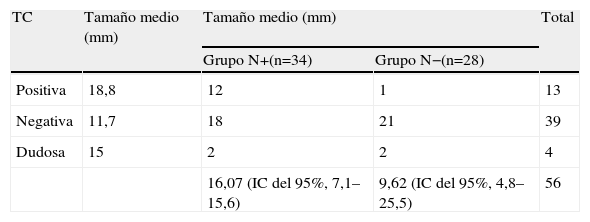la detección preoperatoria de afección ganglionar en el cáncer gástrico es fundamental para el planteamiento del tratamiento neoadyuvante, pero resulta difícil. La tomografía computarizada (TC), un instrumento diagnóstico de primera línea, aporta unos resultados controvertidos. El objetivo del estudio ha sido establecer el rendimiento de la TC helicoidal en la predicción de afección ganglionar para el cáncer gástrico.
Pacientes y métodose ha realizado un análisis preoperatorio y retrospectivo de 62 casos consecutivos de pacientes intervenidos de resección gástrica por adenocarcinoma. Se analizaron la sensibilidad, la especificidad, la precisión y la eficiencia. Se registraron la distribución del número de ganglios aislados, el diámetro del ganglio de mayor tamaño aislado y la precisión por estadio TNM para la afección ganglionar.
Resultadosla sensibilidad de la TC fue de 0,43, la especificidad de 0,96, la precisión de 0,55 y la eficiencia de 0,67. Se observaron diferencias significativas en el diámetro medio entre los grupos con y sin afección ganglionar: 16,29mm (intervalo de confianza del 95%, 7,1–15,6) y 10,25mm (intervalo de confianza del 95%, 4,8–25,5), respectivamente. Se apreció una pérdida de precisión para los grupos N1 y N2.
Conclusionesla TC helicoidal muestra un escaso rendimiento para la valoración preoperatoria de la afección ganglionar. Pese a ello, sigue siendo la técnica inicial de elección.
Knowledge regarding the presence of metastatic lymph node in gastric cancer is of obvious importance when thinking of neoadjuvant therapy, yet it is full of uncertainty. Computed tomography (CT) is one of the first-line diagnostic tools, in spite of controversial results. We aimed to establish the performance of spiral CT in predicting lymph node involvement in gastric cancer.
Patients and methodSixty-two consecutive patients diagnosed of gastric cancer were enrolled in the study. All the patients were examined by CT and imaging results were compared with the corresponding histopathological findings following surgery. We analyzed the sensitivity, specificity, positive and negative reasons, accuracy and efficiency. We also assessed the distribution and number of isolated lymph nodes, the diameter of the largest single nodes and the N distribution according the TNM classification system.
ResultsCompared with the histological results, CT achieved a sensitivity of 0.43, specificity of 0.96, an accuracy of 0.55 and an efficiency of 0.67. An in-depth analysis of the histological lymph node size revealed significant differences between the groups with and without lymph node involvement, with an average size of 16.29mm (95% confidence interval, 7.1–15.6) and 10.25mm (95% confidence interval, 4.8–25.5), respectively (p<0.05). We also observed a diminished accuracy for the N1 and N2 groups.
ConclusionsSpiral CT shows a poor performance for the preoperative evaluation of lymph node involvement. Nevertheless, in case of a positive result, spiral CT is helpful for treatment decision-making in gastric cancer as a first-line staging technique.
Artículo
Comprando el artículo el PDF del mismo podrá ser descargado
Precio 19,34 €
Comprar ahora








